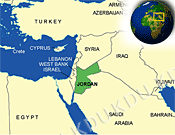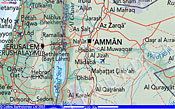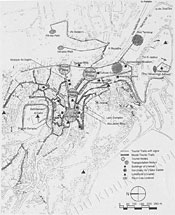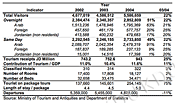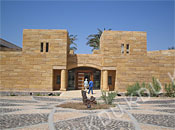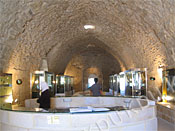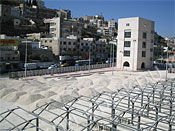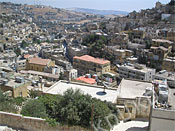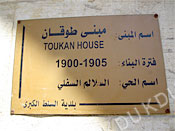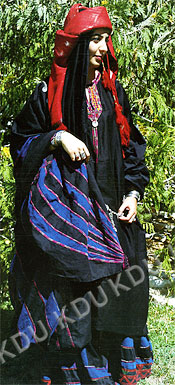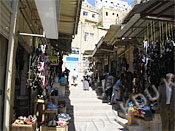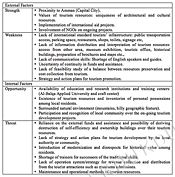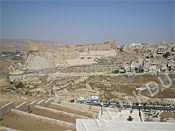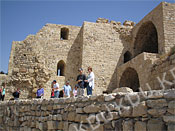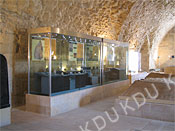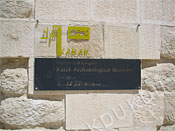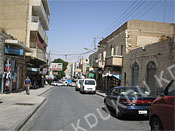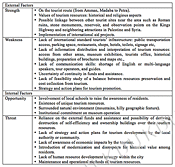![]()
The Regional Resources and Tourism Development in Developing Countries
- A Case Study of Jordan -
![]()
![]()
![]()
![]()
![]()
![]()
According to the World Tourism Organization (WTO), the international tourists' arrival in 2004 was 763 million. The number increased about thirty times from the 1950's mainly due to the introduction of larger passenger aircrafts. The trend of expansion forecasted as continuous 5% increase every year so that it would reach a billion by the year 2010. The current regional share shows the domination of Europe as 50%. However, the increase in Asia and the Pacific and the Middle East were 27.9% and 18.0% between 2003 and 2004, which were higher than that in other regions. This tendency predicted to continue in the future .*1
The positive impacts of tourism development for the region are widely recognized in several aspects of economy, and socio-culture. Tourist spending on such as accommodation, transportation, food and beverage, and shopping are direct revenue for the region. Furthermore, employment and generated raw material supply needs as ripple effects. The facilitation of infrastructure including construction of road, water supply and sewage treatment facilities, waste management plants, and leisure facilities serves for both tourists and residents. Socio-cultural impact is human interaction with people who have different history, culture, and social background. It may enhance the understanding of different cultures and prevent conflicts between them. Therefore, the tourism development perceived as a useful measure for regional development. Meanwhile, noted negative impacts are the decline of natural environment, socio-cultural values, and increase of crime.*2
The positive economic impacts of acquisition of foreign currency and employment generation are highly regarded in developing countries because they tend to promote tourism development as a significant national policy. In order to undertake the tourism development, the formulation of a master plan is essential. However, due to the lack of technology, knowledge, and fund, master plan often formulate under the international supports either by international agencies or by bilateral assistance schemes. Japanese government has been funding tourism master plan studies for more than 20 countries under the Overseas Development Assistance (ODA) budget through Japan International Cooperation Agency (JICA). The recipient countries consist of Southeast Asia, the Middle East, Africa, and South America regions.
Nevertheless, the implementation of the master plan has not been easily realized due to the lack of political, institutional, financial, technical, and human resources. Moreover, the issues of regional impacts other than economic aspect have hardly been discussed. There are also remaining questions of whether or not the tourism development contributes to the regional residents' life. This is recognized as sustainable actions in the future.
The study aims to find out how the tourism development can contribute to the regional development especially where in need of revitalization as well as of sustainability. The attempt to promote the region through tourism development was implemented in many places including Japan and industrialized countries. None of multi solution seems available.
This paper discusses the result of an initial field survey especially in cities named Salt and Karak in Jordan to understand the conditions of tourism development in developing country. Both the Salt and Karak are trying to promote tourism by implementing several projects through different channels including international aid agencies and NGOs. They share the similarity of preserving historical inheritance and recognizing them as their tourism resources. Through looking into the situations of case study cities, some clues of effective and sustainable tourism development for the region may extract and these shall apply to other regions.
The reasons of focusing Jordanian cases were the increasing potential and demand of tourism development in the Middle East and an accessibility of information such as availability of master plan and status of ongoing project, which funded by the Japanese government. The information and material collection of study was carried out in Japan by looking up the publication and website of JICA and Japan Bank for International Cooperation (JBIC) including direct inquires to the division and Jordan office. It included an interview of JICA experts, who had been involved in the tourism development project for several years.
The interviews and site survey in Jordan took place in September 2005. The interviews with officials of Ministry of Public Works, who were in charge of implementation of the projects under JBIC, experts and regional officers of JICA, local contractors of the projects and scholars of Al-Balqa Applied University complemented(Figure 1).
Tourism is considered as an important sector in Jordan's economy. The tourism receipt in 2004 was 943 million JD (1.3billion US$) and contributed to the 11.6% of the country's gross domestic product (GDP) (Table 1.). It is the highest export sector, the second largest private sector employer, and the second highest producer of foreign exchange. Jordan lacks the natural resources for exports such as oil and natural gas therefore, tourism is regarded high in its economic activities.
Despite the negative factors in the Middle East such as war in Iraq and terrorists activities, Jordan has been increasing the number of visitors for last three years. Interestingly, the number of package tour visitors grew more than 75% in 2004. More than half of the overnight visitors are from Arab countries and the share for the same day visitor is also dominant by Arab countries (91%) .*3
According to the Jordan National Tourism Strategy 2004-2010, the vision of tourism is stated as follows: “Tourism is an essential and vibrant growth sector that will contribute to improving the long-term economic and social well-being of Jordanians".*4 It also sets the mission and goal as “Jordan will develop a sustainable tourism economy through a partnership of government, the private sector, and a civil society to expand employment, entrepreneurial opportunity, social benefits, industry profits, and state revenue." And “Double Jordan's tourism economy by 2010 in real terms."
The background of Jordans' strong commitment towards tourism development includes The Study on Tourism Development Master Plan in the Hashemite Kingdom of Jordan, which carried out between 1994 and 1996 under JICA. The Study suggested several potential regions for future tourism development .*5 It followed by the detailed design assistance by the JICA*6 and the result led to the Tourism Sector Development Project (TSDP), financed by JBIC, which targeted four tourism zones in Jordan: Downtown Amman, Salt, Karak and the Dead Sea(Figure 2 and 3).
The project started in 1999 and its component include building or renovation of museums, observation facility, road construction/renovation, and relocation and building of bus terminal. The Karak Archaeological Museum was inaugurated in January 2005, the Dead Sea Museum and the bus terminal in Amman were scheduled to be in operation within 2005 and the renovation of Historic Old Salt Museum is due in April 2006, and the National Museum in Amman is to be completed by 2007 (Picture 1.2.and3).
With the development of these museums, training of museum staff and cooperation has already taken place over the past three years. One of the curators of the museum in Karak was sent on a JICA training course in Museum Management Technology in Japan in 2002 and several Japanese volunteers were assigned to Jordan. In 2004, JICA dispatched the long-term experts to the museums in order to provide training for museum staff and materials and equipment preparation for the exhibition.
The Salt is also known as the final resting place of the Prophet Ayyoub, whose legendary patience and faith gave him strength to pursue hardships were mentioned four times in Quran. Along with its historical and religious characters, local handicraft work is peculiar. It includes ceramics, weaving, silkscreen printing, embroidery, and dyeing. The largest dress in the world is in exhibition at the Archaeological & Folklore Museum (Picture 6).
The JBIC issued Yen Loan for tourism development project in Salt to renovate the 100 years old mansion known as the House of Abu Jabel, who was the famous merchant, into a historical museum. It will be the tourist attraction as an information distribution center, which may connect the existing historical resources such as designated historical buildings and the tourist spots like Archaeological & Folklore Museum.
The project also facilitated the pavement of a market area and walking trails in the city, which can contribute to both tourists and residents. According to the JBIC project manager, residents who were anxious about the project became supportive about it once they experienced the provision of conveniences such as trails, which serve for their daily activities (Picture 7).
In order to promote the awareness and ownership of residents, JICA volunteers visited the houses to prepare the inventory for the museum exhibition. Meanwhile, NGOs are carrying out the programs to reserve the weaving, embroidery, and dyeing. It also serves to empower women in the region. A Japanese graduate student is also carrying out a research in Salt for the conservation of cultures. She produced a detailed map of interests in Japanese version in Salt.
There is an academic institution named Al-Balqa Applied University in Salt. The university was established in 1997 with 16 colleges for two years courses in different location in Jordan. Its objectives are not only to provide educational opportunity for younger generation but also to cooperate with local community. Therefore, it aims to teach practical skills. The interview with the Professor Dr. Jameel Al-Jaloudi, Dean: Faculty of Planning and Management took place during the site visit. He mentioned that the Salt residents generally appreciate the historical resources and their value of their city and an awareness of preservation needs seemed to be prevailing. However, the transfer of traditional skills did not carried out in many areas. He mentioned that construction and craft making skills require special attention near future. The university is proposing the government to launch a national park facilitation project near the city in the remains of mine site.
Provisionally, the study applied the SWOT (Strength, Weakness, Opportunity and Threat) analysis in Salt to find the tourism development value in term of regional development (Table 2). The SWOT analysis is the common methods to analyze resources, products, and services when marketing measures are in preparation. It defines Strength and Weakness as external factors, opportunities, and Threat as internal factors when evaluating the targets in order to evaluate them .*7
Based on the above, it can be said that Salt holds its potential as a tourist destination with its unique tourism resources in both history and culture. The crucial weak point is the lack of strategy and action plans as well as the identification of responsibilities especially after the completion of on-going funded projects. The sustainability and feasibility of tourism development specified in Salt needs to be examined and an action plans shall be determined. The other serious issue is who will be in charge of the tourism development and management in the area and who will operate the whole resources. It includes operation and maintenance of the renovated museums and linkage between tourists' spots. Especially in the case of a developing country or a small city like Salt, it is so burdensome to leave the matter to the local authority that national governmental commitment (at least the ministerial level) may be required to some extent.
Meanwhile, the city can start setting reasonable goals such as to be the one day excursion destination from Amman or the stop on the way to the North region, where is popular summer holiday destination among Arab tourists. The weak points may be that, Salt lacks the tourists' infrastructure such as accommodation, restaurants, or public facilities. Becoming to be the over night destination immediately is not yet recommended. If the popularity of Salt extended, it may start with establishing tourism infrastructures. One of the historical buildings may be transformed into a hotel, then attract special interest tourists who are keen to experience the Ottoman architecture. Nevertheless, minimum improvement shall undertake in some areas including signage and public facilities. The facilitation of signage connecting tourist resources and routes and guidance of resource values will add to assist the understandings of tourists. The guide maps and brochures of tourism resources by multi-languages will also help attract international tourists. These can easily distribute in Amman or other major tourists' sites in the country. Moreover, the human resource development shall be emphasized in terms of preserving techniques such as skills of traditional building construction methods, weaving and craft's makings. It must take quick action while the skilled persons are available for teaching. This may be realized through several channels including Al-Balqa University, vocational schools, and NGOs.
The Karak locates 90km South of Amman with population of 19,000*8 and stands 1km above the sea level. Karak is a road junction and an agricultural trade center. The ancient Kir Moab (also mentioned in the Bible as Kir Hareseth, Kir Haresh, and Kir Heres) was the walled citadel of the Moabites. Karak played an important role in the Crusades. The lordship of Karak was one of the chief baronies of the Latin Kingdom of Jerusalem. The brigand Reginald of Châtillon was lord of Karak when, in 1187, he attacked a caravan led by Sultan Saladin and thus provoked the events leading to the fall of Jerusalem. Saladin took Karak in 1188 after a long siege. It was an archiepiscopal see from the early Christian era until the Christians was massacred or expelled in 1910. A 12th-century castle built by the Crusaders at Karak is the major tourist attraction especially those who are interested in the bible related remains (Picture 8, 9). The French are the most visited tourists abroad and it hosts about 1,000 tourists per month.*9 The access to Karak is often from Madaba via Kings Highway, which is known as its spectacular ravine scenery. It is also on the way to Petra. Therefore, the current tourists spend only a few hours in Karak visiting castle and lunching on their way to Petra. There is only one major restaurant near the castle. Nevertheless, it operates by the Egyptian investor that whether or not it benefits to the local economy of Karak is uncertain.
JBIC carried out several Yen Loan projects including two observation decks, the renovation of Karak Archeological Museum, which locates inside of the castle, the facilitation of visitor center, and the pavement. World Bank (WB) is funding the restoration of castle outer walls. JICA provides long-term specialists for coordinating museum exhibitions and museum staff training (Picture 10). Currently, the museum is under operation by two curators from Karak who belong to the Ministry of Tourism and Antiques. Training of local tour operators and tour guides are also under the scope of JICA project, which now depend on the tour operator or guides/attendance who accompany with tourists group from Amman or their origin countries. Some educational activities such as a job experience of being a curator for one day and excavation work are under implementation targeting local schoolchildren. It aims to stimulate their interest of their history and heritages as well as expected to build their ownership. For the exhibition of museum and some highlights in the castle, the same character sign of Lion used to guide the tourists (Picture 11).
However, the current standard of restaurants, hotels, shops, public toilets, parking and signage for tourists are insufficient in both quantity and quality. There is a so-called “Tourist Road" designated by the Ministry of Tourism and Antiques though, it does not show much difference with the ordinary local shopping streets of Karak (Picture 12).
Based on the SWOT analysis (Table 3), it can be said that Karak's potential as a tourist destination depends on how it can establish the linkages between other tourist sites and resources with utilizing unique heritage of castle and its museum. The crucial threat is the lack of strategy and action plans for tourism promotion specified in Karak. If it tries to serve as a stop-over destination for a while, the strategy must target how it can increase the tourism arrivals, their time spending in Karak, and total revenue. Thus, the improvement of souvenir shops, introduction of local crafts and delights, diversifying food choices, and provision of archeological experiences (i.e., excavation tours, study tours) are necessary. However, these new tourism products need coordination by major institutions. It requires a thorough coordination with tour operators, guides, and more importantly, with the public relations in other areas especially in Amman, Madaba, and Petra. Once the number of tourists increased and revenue became stable, Karak may extend its capacity to overnight destination along with more varieties of tourist activities. Meanwhile, In terms of the tourist infrastructure, it is better improving the façade of “Tourist Road" in order to attract visitors. Public toilets and signage for tourists must be facilitated in several points in the city. This will make tourist possible to walk around the city.
Moreover, the operation and maintenance plans of the existing resources such as castle and museum, must be formed especially from a financial point of view. Whether or not the city of Karak can manage the maintenance and operational costs including personnel expenses by collecting admission fee or governmental subsidies should be determined. The sustainability of Ministry's commitment is also necessary.
Building the awareness of residents over their history and tourism resources is another focal aspect. Without the substantial support by the residents, tourism may not survive in a small city like Karak. The expansion of educational activities/experiences at the museum for schoolchildren can coordinate along with introduction of adults' programs.
In general, regional development requires long-term plan, which should reflect the desirable future of the region along with short-term action plans. The role of tourism development in the regional development may differ depending on the characteristics of regions. Tourism development can be a strong tool to revive the region if the regions are rich in tourism resources. This does not apply to most of the regions, in search of their revitalization schemes. Therefore, the tourism development should be taken as a part of their entire regional plan. The application of it needs to be thoroughly determined, especially when they consider the investment on infrastructure and major changes on existing natural and cultural environment. Without the clear visions and perspectives about their utilization, maintenance, operation, sustainability in monetary, institutional structure, and human resources, they may become the weak points or burden of the region in the future. It applies not only to developing countries but also to local regions in industrialized countries. In the case of developing countries, it is difficult to compose comprehensive plans due to the lack of independence in the decision-making and funding shortages among local authorities over regional planning. Thus, the tourism development shall start with capable actions with utilizing the resources in the region with minimum investment.
As a conclusion of this study, the following aspects of tourism development procedure can be possibly identified from the case of Salt and Karak in Jordan. These items may be applicable to other regions as well.
1) Utilization of available tourism resources such as historical architectures, religious remains, and cultural inheritance with building the linkage between other tourist attraction near the area and tourist rout design.
2) Applying measures for renovation and re-routing of existing tourism resources. It will make use of available resources and creation of network among them.
3) Provision of technical assistance from the outside including internationally funded projects and NGOs.
4) Encouraging involvement and building ownership of local residents in tourism development activities. It is found in the example of inventory research and awareness building activities by funding agencies and NGOs.
5) Utilizing and enhancing existing training and educational institutions. It includes primary, higher, and vocational levels.
The study plans to extend the case study research in other regions including the Middle East and Asia. The comparison of several cases may bring the concrete pictures of feasible and sustainable tourism development contribution in regional development.
This is to express our sincere gratitude towards personnel from JICA, JBIC, Ministry of Public Works, Jordan, Al-Balqa Applied University, and others, who agreed for interviews and provided profound information regarding the tourism development in Jordan. Without their assistance and guidance, we would not be able to access the sites as well as to grasp the conditions. Furthermore, the study was carried out under the co-research project funded by the Kobe Design University.
1) Ministry of Ministry of Tourism & Antiquities [Jordan National Tourism Strategy: 2004-2010], 2004
2) Atlas Tours Net, [Website: http://www.atlastours.net/jordan/salt.html], 2006
3) Ministry of Tourism and Antique Jordan, [Website: http://www.kinghussein.gov.jo/tourism2.html],2006
4) Department of Statistics Jordan, [Website: http://www.dos.gov.jo/dos_home_e/main/index.htm], 2006
5) Hoteljobrsource.com, [Middle East Hotels-Trend and Opportunities 2003, http://www.hoteljobrsource.com/menu/article6215.html], 2006
6) CIA, [Country Fact Sheet Jordan], https://www.cia.gov/redirects/factbookredirect.html , 2006
7) JICA, [Tourism Development through Museum Activity], http://www.jica go.jp/evaluation/before/2004/jor_01.html, 2006
8) Ministry of Foreign Affaires, [ODA mail magazine Japan] , http/www.mofa.go.jp/mofaj/gaiko/oda/,ail/bn_71.html, 2006
9) JICA, [JICA Jordan Activities: The Expert for Tourism Development at the Ministry of Tourism and Antiquities], http://www.jica.go.jp/jordan/activities/09_01.html, 2006
*1― WTO World Tourism Barometer、World Tourism Organization、Volume3 No.3 October 2005
*2― Ayako Higuchi, Kanko ga tojoukoku ni ataeru eikyou ni tsuite (The Impacts of Tourism in Developing Countries), Keio Univ., 1999, Takashi Shimakawa, Kanko kaihatsu project no mondaiten (Problems of tourism development projects), Matsushita Seisaku Jukuhou, 2000, Kayoko Ishii, Shakaisei no aru kankou kaihatsu wo mezasite (Toward the socialized tourism development), Japan Foundation Research Report, 2001
*3― The definition of Arab countries includes Algeria, Bahrain, Comoros, Djibouti, Egypt, Iraq, Jordan, Kuwait, Lebanon, Libya, Mauritania, Morocco, Oman, Palestine, Qatar, Yemen, Saudi Arabia, Somalia, Sudan, Syria, Tunisia, United Arab Emirates, and Western Sahara/Sahrawi Arab Democratic Republic.
*4 ―Jordan National Tourism Strategy: 2004-2010, Ministry of Tourism and Antiquities the Kingdom of Jordan, 2004
*5 ―The study on the tourism development plan in the Hashemite Kingdom of Jordan : final report : executive summary、Japan International Cooperation Agency (JICA) : Nippon Koei Co. Ltd. : Padeco Co., Ltd. : Regional Planning International Co., Ltd., 1996
*6― Detailed design for tourism sector development project in the Hashemite Kingdom of Jordan : executive summary、JICA : Pacific Consultants International : Yamashita Sekkei Inc. 2000
*7― Marketing Words, http://www.mitsue.co.jp/case/glossary/m_020.html
*8 ―Estimated figure in 1997 (http://www.world66.com/asia/middleeast/jordan/karak).
*9 ―According to a JICA specialist, who coordinates the museum exhibition.

